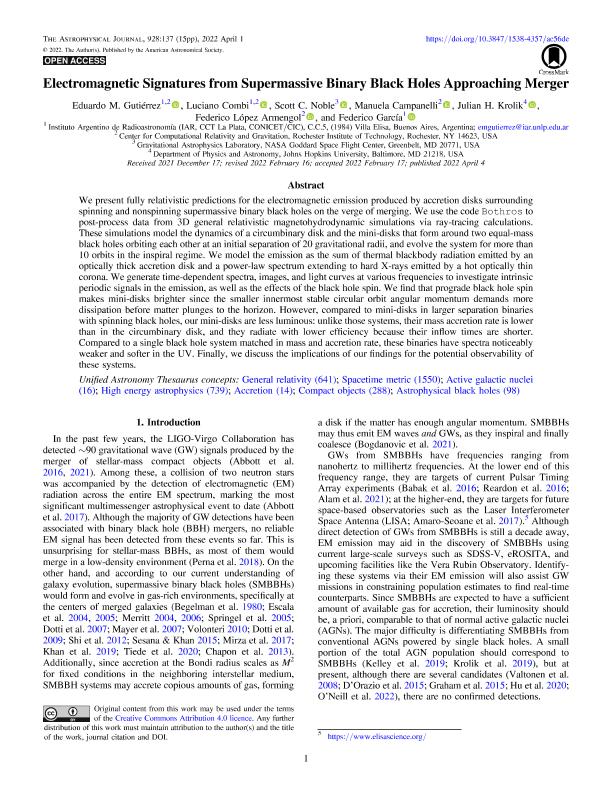Mostrar el registro sencillo del ítem
dc.contributor.author
Gutiérrez, Eduardo Mario

dc.contributor.author
Combi, Luciano

dc.contributor.author
Noble, Scott C.
dc.contributor.author
Campanelli, Manuela
dc.contributor.author
Krolik, Julian H.
dc.contributor.author
López Armengol, Federico
dc.contributor.author
García, Federico
dc.date.available
2023-07-14T13:53:05Z
dc.date.issued
2022-04
dc.identifier.citation
Gutiérrez, Eduardo Mario; Combi, Luciano; Noble, Scott C.; Campanelli, Manuela; Krolik, Julian H.; et al.; Electromagnetic Signatures from Supermassive Binary Black Holes Approaching Merger; IOP Publishing; Astrophysical Journal; 928; 2; 4-2022
dc.identifier.issn
0004-637X
dc.identifier.uri
http://hdl.handle.net/11336/203945
dc.description.abstract
We present fully relativistic predictions for the electromagnetic emission produced by accretion disks surrounding spinning and nonspinning supermassive binary black holes on the verge of merging. We use the code Bothros to post-process data from 3D general relativistic magnetohydrodynamic simulations via ray-tracing calculations. These simulations model the dynamics of a circumbinary disk and the mini-disks that form around two equal-mass black holes orbiting each other at an initial separation of 20 gravitational radii, and evolve the system for more than 10 orbits in the inspiral regime. We model the emission as the sum of thermal blackbody radiation emitted by an optically thick accretion disk and a power-law spectrum extending to hard X-rays emitted by a hot optically thin corona. We generate time-dependent spectra, images, and light curves at various frequencies to investigate intrinsic periodic signals in the emission, as well as the effects of the black hole spin. We find that prograde black hole spin makes mini-disks brighter since the smaller innermost stable circular orbit angular momentum demands more dissipation before matter plunges to the horizon. However, compared to mini-disks in larger separation binaries with spinning black holes, our mini-disks are less luminous: unlike those systems, their mass accretion rate is lower than in the circumbinary disk, and they radiate with lower efficiency because their inflow times are shorter. Compared to a single black hole system matched in mass and accretion rate, these binaries have spectra noticeably weaker and softer in the UV. Finally, we discuss the implications of our findings for the potential observability of these systems.
dc.format
application/pdf
dc.language.iso
eng
dc.publisher
IOP Publishing

dc.rights
info:eu-repo/semantics/openAccess
dc.rights.uri
https://creativecommons.org/licenses/by-nc-sa/2.5/ar/
dc.subject
General Relativity
dc.subject
Accretion
dc.subject
Astrophysical black holes
dc.subject
High-Energy Astrophysics
dc.subject.classification
Astronomía

dc.subject.classification
Ciencias Físicas

dc.subject.classification
CIENCIAS NATURALES Y EXACTAS

dc.title
Electromagnetic Signatures from Supermassive Binary Black Holes Approaching Merger
dc.type
info:eu-repo/semantics/article
dc.type
info:ar-repo/semantics/artículo
dc.type
info:eu-repo/semantics/publishedVersion
dc.date.updated
2023-06-29T17:53:59Z
dc.journal.volume
928
dc.journal.number
2
dc.journal.pais
Reino Unido

dc.description.fil
Fil: Gutiérrez, Eduardo Mario. Rochester Institute Of Technology; Estados Unidos. Provincia de Buenos Aires. Gobernación. Comisión de Investigaciones Científicas. Instituto Argentino de Radioastronomía. Consejo Nacional de Investigaciones Científicas y Técnicas. Centro Científico Tecnológico Conicet - La Plata. Instituto Argentino de Radioastronomía; Argentina
dc.description.fil
Fil: Combi, Luciano. Provincia de Buenos Aires. Gobernación. Comisión de Investigaciones Científicas. Instituto Argentino de Radioastronomía. Consejo Nacional de Investigaciones Científicas y Técnicas. Centro Científico Tecnológico Conicet - La Plata. Instituto Argentino de Radioastronomía; Argentina. Rochester Institute Of Technology; Estados Unidos
dc.description.fil
Fil: Noble, Scott C.. Nasa Goddard Space Flight Center; Estados Unidos
dc.description.fil
Fil: Campanelli, Manuela. Rochester Institute Of Technology; Estados Unidos
dc.description.fil
Fil: Krolik, Julian H.. University Johns Hopkins; Estados Unidos
dc.description.fil
Fil: López Armengol, Federico. Rochester Institute Of Technology; Estados Unidos
dc.description.fil
Fil: García, Federico. Provincia de Buenos Aires. Gobernación. Comisión de Investigaciones Científicas. Instituto Argentino de Radioastronomía. Consejo Nacional de Investigaciones Científicas y Técnicas. Centro Científico Tecnológico Conicet - La Plata. Instituto Argentino de Radioastronomía; Argentina
dc.journal.title
Astrophysical Journal

dc.relation.alternativeid
info:eu-repo/semantics/altIdentifier/doi/http://dx.doi.org/10.3847/1538-4357/ac56de
dc.relation.alternativeid
info:eu-repo/semantics/altIdentifier/url/https://iopscience.iop.org/article/10.3847/1538-4357/ac56de
Archivos asociados
